- Getting around Lijiang. Dont stay in the Old Towns more than 2 days, there is nothing to do. KRISS Oct 9, 2013 05:46
- 2013 Beijing Temple Fair BENNYLAU Feb 26, 2013 03:29
- Malaysian traveling from KUL - LAX vis Shanghai PVG ZATI_DY Jan 3, 2013 20:15
The Little Light of Lingao Jiao
- Views: 6399
- |Vote: 0 0
- |Add to Favorites
- |Recommend to Friends
It’s dusty, dry and colourful. The streets around the bus station are buzzing with people and motor cabs of every colour imaginable. I’m on my way to the coast, another seven or eight kilometres from town but the responses to my inquiries about public transport are vague. I narrowly avoid being run over by the cavalcade of motorcycle cabs as I gaze hopefully down the dusty street. There is no sign of any buses in the direction I have been advised to look. A few more questions and I begin to wonder if this will be another of those fruitless expeditions off the beaten track in search of one of my odd passions.
Having lived half my life in the shadow of a modern lighthouse I am still mystified by what it is that draws me. Whether influenced by stories my father recounted of his years as a seaman tending the Lights, or of tragic tales and miracles told of early wrecks along our southern coast, or is it the stoic solitude of Lights in lonely isolation in wild and windswept landscapes? Each Light has a story, and a secret perhaps of the passing of ships through the passage of time - of calm and calamity, of ships that have floundered and those that sailed on, of lives that were lost and those that survived. Each Light is unique, each purpose the same, a beacon of hope, a symbol of safety, giving direction and warning of danger. Whatever the weather their task is routine.
Long gone are the keepers of old, replaced by new and automated equipment. Yet this has not diminished the glow of mystery and romance that emanates from these historic beacons. Thus my fascination for lighthouses has lured me down the North West coast of Hainan. Like navigators before me, I’m trusting that I’ll not come to grief along this lonely stretch. In the absence of any sign of a bus I agree to take a san lun che for just Y20. A few kilometres later I have more doubts as we bounce relentlessly along the unpaved road. It seems to me that we have hit every pothole and stone on the road. Any shock absorbers – had there been any – have long since been destroyed, and never been replaced.
The land is flat and uninspiring. Periodically we pass an ox drawn dray of a local farmer or another motorcycle cab returning to town. Closer to the coast a few tell tale signs appear. Tall casuarinas, those coastal oaks, gracefully line the road which by now is just a sandy track. Before we get a chance to see the water however we hit a snag. Not a serious disaster but a flat tyre which is no surprise considering the condition of the road. The only sign of life around here is a cluster of fishermen’s huts and shanties and three rough stalls selling cold drinks, cigarettes and cards. My driver pulls up to one of these and they send for help.
Lying in the lee of the coastal sand dunes it’s a lonely and desolate community. I wonder what it will take to repair the tyre and get us back on the road. At each of the stalls, a group of adults plays cards while the kids ramble barefoot nearby. There’s little traffic - just a few self drive tourists out from Haikou for the day. When the mechanic arrives, he has a grinder and a pump and little else. He unlocks the door to a small room under the roof of the shelter revealing a supply of electricity and water on tap – two essentials for the task at hand. In less than thirty minutes the repairs are complete, the grinder used to remove a hard old patch before replacing it with a fresh new one. For the princely price of Y2 we are on our way again.
While the repairs are under way, I rest up on the bare timber bed base in the shade of the shelter surveying my surroundings. Heaps of large black basalt building blocks lay beside a narrow lane from whence the mechanic came. Others form rough dry stone walls outlining property and pathways. There’s not a blade of grass in sight. Adding a few shades of green are windswept coconuts, beach almonds, coastal casuarinas and some weedy looking bushes beside the haphazard piles of timber, branches of trees and bits of driftwood.
The beach at the end of the track is all but empty. It is home to a small fishing fleet with boats and bundles of nets hauled up under makeshift shelters. A more considerable amount of litter washed up with each tide lies strewn about the beach. The sand is coarse and heavy and gold in colour with a hint of volcanic red. The same tall windswept casuarinas overhang the beach sheltering more makeshift fishing huts and gear. I scan the coastline north and south for a lighthouse that I imagine stands tall and proud upon a headland. There is no sign of a cape or Light in either direction but my driver knows what I am looking for.
Along another track to the south running parallel to the beach, we pass an unfinished and abandoned hotel complex – the only sign of a modern life. Just beyond this we pull into a large open area, recently cleared beside the lighthouse compound. Lingao Light is small, neat and unassuming, freshly painted white with two red stripes, standing on the lowest point of ground around the cape. Lingao Light built in 1894 and perhaps just 15 metres tall is crafted in steel and heavily braced with metal stanchions. Today it is still an important beacon for the passage of shipping through the Qiongzhou Straits. Beautifully crafted in sandstone and no doubt also recently restored, the keeper’s houses are surprisingly, both quaint and colonial. The two small and almost identical buildings to leeward of the Light are surrounded by neat, trim gardens.
Lingao Cape is also small, neat and unassuming and barely metres above sea level – not quite what I had envisaged. A tongue of black volcanic rocks forming a spit juts 250 meters into the sea to the south. A huge sculpture of revolutionary soldiers stands on the edge of the spit at the tip of this otherwise sandy cape looking north. In its shadow a couple shoot photos for their wedding album. Smooth black baseball-sized rocks litter the sandy beach disappearing into the water. Looking south from the Cape I notice a fleet of open fishing boats at anchor just off shore, red flags fluttering gently in the breeze. Almost obscured by trees behind the long beach, sweeping away to the south are signs of a village that I’m curious to explore.
The whole area has recently been upgraded, landscaped and fenced with a new entrance and a ticket price of Y20. But for now there’s little to interest the visitor unless, like me they are drawn by the searching lights of remote beacons. My driver takes me down onto the beach to avoid paying the entrance fee, at least for now. After rounding the tip of the Cape we slip inside the fence to explore the lighthouse grounds. Also within these ticketed grounds are a maze and a raised boardwalk with lookouts across the maze, the gardens and the straits. The site will eventually include a museum and the lighthouse buildings may eventually be opened to the public. Now that we are inside without tickets and very few other visitors we make the mistake of exiting through the ticket gate where I am sure to be noticed. My driver being a local is exempt it seems so I plead my case that there is as yet nothing to see.
Before going any further I negotiate with my driver to take me back to Lingao. There’s nowhere to stay and little public transport so I do run the risk of being marooned here. Before we leave I want to have a quick look at the fishing village behind the beach. My driver asks for more money for this little excursion but having already offered her more than double our original fee I manage to keep her to the deal. She reluctantly agrees and grumbles loudly and profusely as we go, spoiling an otherwise pleasant time for me. This track is far worse than anything else we’ve been over and with one flat tyre already her grumbling is well justified.
Here the beach is wide and relatively flat, an ideal workspace for fishermen and their wives to maintain their small timber boats and mend their nets. Many of the village houses and garden walls are built of dark grey almost black stones hewn from the local volcanic rocks, the same rocks that flow seaward forming Lingao’s spit. The village is dry and dusty and strewn with litter. Large nets filled with styrofoam lay about the beach like the discarded balls of giants. Once a useful material for floatation at sea and a light weight packing material onshore it’s now a huge and unsightly source of non - biodegradable effluence. On the up side it’s a source of extra income for these poor fishing communities.
The little Light at Lingao Jiao may not stand so tall but like every Light along the shore she serves her purpose well. Lingao Light may not be world renowned but is well respected nationally, honoured with a place on China’s postage stamps in 2002. This lonely little Light now joins my ever growing list and I will remember her. She revealed to me no secrets, but she saw me safely to and fro and on my passage south. Safely back in Lingao town, I grab a late lunch before catching the mid afternoon bus to the central highlands leaving the red soiled, dry and dusty lowlands behind me.



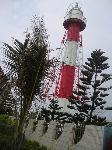
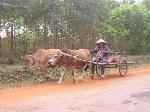
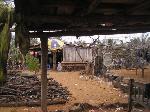

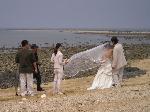
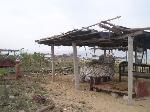
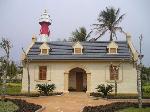
 Copyright © 1998-2025 All rights reserved.
Copyright © 1998-2025 All rights reserved.